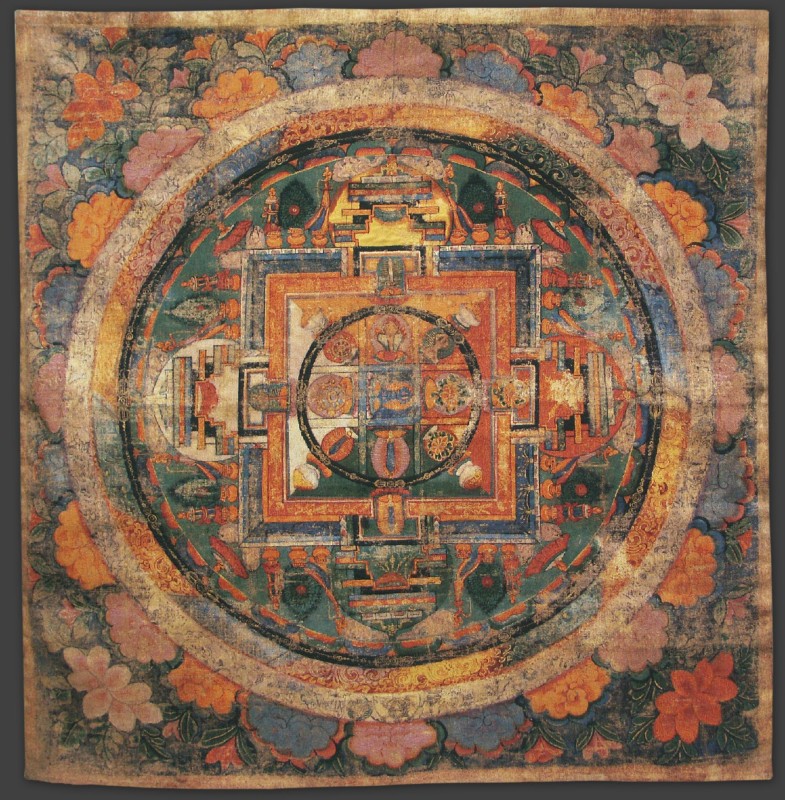
Jacquard tapestry
81 x 81 in
edition of 24
This tapestry is enlarged and interpreted from an18th century painting:
Mandala of the Five Buddha Clans- 15 x 15 inch
Amdo Style, 18th century
Dr. Robert Thurman, the renowned American scholar of Tibetan art and religion, has defined the Sanskrit word mandala as a sphere or container of essence. In the Hindu Vedic Brahmanas, mandala signifies both a place for ritual and a sacred enclosure. In fact, the Hindu temple follows the mandala plan, functioning as a space to move from ordinary reality to nonordinary reality; it aligns devotees with the deepest energies of the cosmos embodied in sacred geometry. By placing himself or herself at the center of an internal mandala, the meditator accomplishes the same goal while utilizing the energies of the cosmos for self-transformation. In the words of the great Tibetologist Giuseppe de Tucci, the mandala is a pscyhocosmogram.
As with many other mandalas, the basic features of this mandala of the Five Buddha Clans are: a ring of eight graveyards, a circle of flames, a circle of vajras and four gateways or portals that are oriented to the four directions.
The eight graveyards (places where Tantric yogis go to purify themselves of attachments and aversions) also represent the eight aspects of individuating consciousness that bring about existential reality. The five senses and the mind store consciousness where trace memories of former incarnations and consciousness itself exist. The expectation is that the meditator will go beyond these aspects of individuating consciousness as he or she moves from samsara to nirvana, from ordinary reality to the deepest levels of sacred reality.
The next circle in the mandala is a fire barrier to protect the adept from both outside forces and inner distractions that would interfere with the meditative process. At this point, the meditator has already experienced a degree of spiritual transformation, symbolized by the circle of lotus petals; the next circle of vajras (adamantine scepters) signifies the attainment of still greater inner powers and wisdom. Finally, the gates are portals into both higher levels of consciousness and the profound energies of the cosmos.
The Five Buddha Mandala or Smayamandala is a mandala without figures, containing only symbols: the sword of flaming wisdom, the lotus, the chakra, and the vajra. At the center (a direction in Buddhist cosmology) is the blue Buddha Akshobhya, transmuting anger into wisdom with his vajra. In the East is the white Buddha Vairochana transmuting delusion into wisdom with his chakra. In the south is the gold Ratnasambhava, transmuting pride into wisdom with his wish-fulfilling gem. In the west is the ruby red Amitaba, who transmutes lust into wisdom with his lotus. In the north is the emerald green Amoghasiddi, who changes envy into wisdom with his sword.
The colors of the Buddhas also symbolize the five elements: ether, water, earth, fire and air. As the meditator dissolves into the Ultimate Void or comes out of the Void (the last stage of mandala involution or the first of mandala evolution), he or she sees a five- colored light which relates to these elements. Indeed, one of the goals of mandala practice is the realization that the substantiality of phenomenal reality is an illusion; it is composed of elements, but these elements are essentially colored light, and more essentially the pure energy of the void.
— Mark Levy
A portion of the proceeds from the sales of this edition are donated to the Tibet Fund, a nonprofit which preserves the cultural, religious and national identity of the Tibetan people, and through them the Shalu Monastery in exile and the Tibetan Children’s Village, a shelter and school for Tibetan orphans.
show prices
Prices and availability are subject to change without notice.The copyright of all art images belongs to the individual artists and Magnolia Editions, Inc.
©2003-2024 Magnolia Editions, Inc. All rights reserved. contact us
